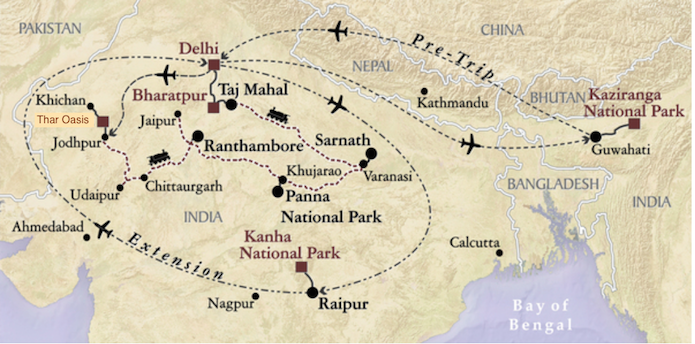
Today we drove from Kanha to Nagpur and flew back to Delhi
(Image courtesy of VENT)
(Click on images to enlarge)

|
We got up so early in Kanha this morning that our taxi departed at 4:58.
We’d actually wakened before the alarm, thanks to the “brain fever
bird,” the Common Hawk-Cuckoo, whose
increasingly excited
calls could wake anyone. My first observation of the day was that, based on
my sample so far, all Indian taxis have a figure of Ganesha on the dashboard.
For the first few hours, we drove along in the dark watching the road ahead of us for crossing wildlife. Gajendra later told us that he saw another Jungle Cat (he was in the other taxi), but Lee and I spotted only bats. Once there was daylight, we could see that we were passing through rice paddies and villages much like those near Kanha. As everywhere else we’ve been in this country, there were billboards advertising schools. Parents here make huge sacrifices to pay for their children’s education. As we neared the edge of the plateau, we stopped at a rest area and immediately noted the resident macaques, mostly females with young. There was a large, very prejudicial poster with the most aggressive possible photo of a macaque that proclaimed “BEWARE!”, but we had no trouble from them. The little ones swung frenetically from the vines of a huge banyan tree. |
Macaque defamation |
|
Puzzled young Rhesus Macaque |
For the next several miles, both on the plateau and down below, there were
macaques along the road. I was impressed (and relieved) to see one of them look
both ways before crossing the road. Often one sees a macaque or a langur
standing looking at the traffic with a puzzled expression on its face as though
trying to figure out why Evolution has left it behind. I can hear Douglas Adams
saying, “The secret is to bang the rocks together, guys!” One
can’t help having a primate fellow-feeling with the tribe of Hanuman.
They are just so like us. Dion told us a few days ago of his horror at seeing
a Wild Boar eating a dead monkey. I can see how he would feel that.
In one small town we passed through, we noticed a white cow covered with colored powders. I’d been wondering yesterday why none of the cows around Kanha had gotten themselves ambushed. We continued through larger towns and onto a motorway. I felt a bit dismayed at the very large sign before each toll booth listing the people who are not required to pay tolls (by position, not name). India seems to have promoted the concept of VIP to quasi-legal status, which surely can’t be good for “the world’s largest democracy”. Even on the divided motorway, there were many animals on the road, the random cow crossing it or whole herds being driven along it, not to mention the monkeys and dogs and much else. But we have seen essentially no roadkill in India. It can’t just be that the vultures clean it up quickly, so I suppose people take more care. |
 Newly-discovered Harappan tiger seal from Rakhigarhi (Image courtesy of the Hindustan Times) |
We were pleased when we remembered that the US is switching to Daylight Savings
Time today, which gives us one fewer hour of jetlag to deal with when we do get
home (“only” 9.5 hours).
As we have been somewhat isolated out in the national parks, it was good to have a chance to catch up on the news a bit. Today’s Hindustan Times had a couple of articles very relevant to us. One said that the protected forests around Delhi have seen a huge drop in both resident and breeding bird species in recent years (numbers like 42% in the last two years). This is attributed to the lack of protection for nearby wetlands, which are being used as garbage dumps. The other reported on a study of the wild tiger populations at the 47 reserves, which said that only five of the the preserves can support a large enough number of breeding females to provide sufficient genetic diversity. It concluded, “If we don’t have the green corridors connecting tiger reserves, our protected areas could become glorified zoos.” I suppose that one can take some comfort in the fact that these stories are considered news-worthy. |
|
Love to you all, Melinda |

